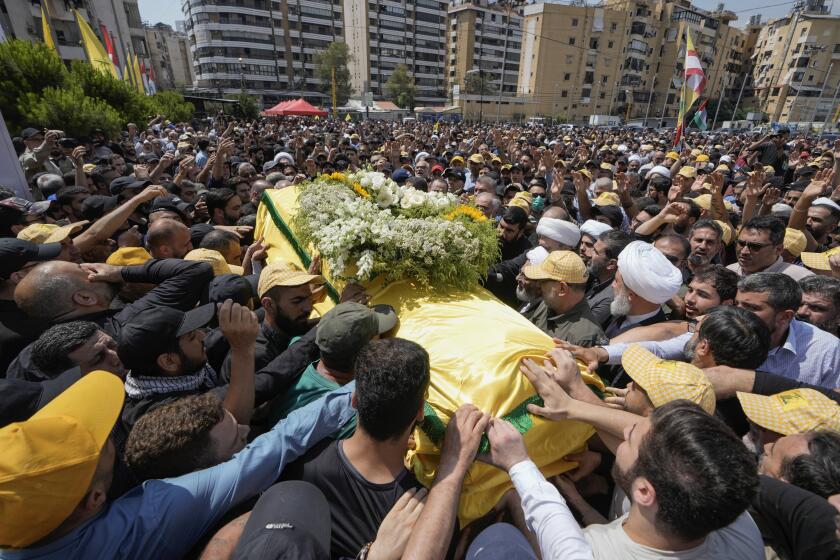With Missiles Gone, Europe Faces Defense on the Cheap
The efforts of Congress and the Reagan Administration to reduce the defict, and the upcoming agreement with the Soviet Union on an intermediate-range nuclear force treaty, create major new complications for U.S. policy toward the North Atlantic alliance.
One of these complications is that we are not going to replace the nuclear weapons that we’re withdrawing with improved conventional forces.
Neither are we going to pay for conventional defense initiatives. Even before the latest round of budget cuts, America was falling far short of the procurements necessary to modernize tactical air forces and cutting back on Army modernization programs. The current budget crisis makes it all too clear that all our plans to modernize our existing forces for NATO will have to be cut further in the future.
New technology will not bring substantial savings to our defense budget. In spite of two decades of techno-babble about “force multipliers,” our research and development community has never produced even one real “force multiplier” at anything like the cost and effectiveness it has promised. Worse, our weapons deployment times have been so slow that the Warsaw Pact has quickly overtaken us in every case: anti-tank guided missiles, surface-to-air missiles, armored vehicles, attack helicopters and a host of other categories.
As for military reform, there are no magic answers to the problem of building a more robust conventional defense option in Europe. Once all the usual ideas are examined in the brutal light of changing specific specific forces within the existing national manpower and financial constraints, they are exposed as impractical and unimplementable. NATO armies, navies and air forces already have made virtually all the compromises and adjustments they can. Significant increases in military capability will be made only if NATO gets significant increases in resources.
This means that the INF treaty will ultimately do nothing to reduce our dependence on nuclear weapons or reduce the risk of nuclear war. Given the fact that the Warsaw Pact continues to modernize its conventional forces at two to three times the rate of NATO, an already unfavorable conventional balance will shift steadily against us. This, in turn, means that we must become more dependent on the threat of nuclear escalation to compensate for our conventional weakness.
The INF treaty only affects intermediate-range missiles, not their warheads. It allows each side to keep the nuclear weapons removed from their missiles and does not require the total holdings of Warsaw Pact forces in Europe to be reduced by a single nuclear weapon. As a result, NATO will be thrust back into greater reliance on its less accurate sea-based nuclear delivery systems and its older nuclear-strike aircraft. The naval systems cannot be targeted as precisely as the systems we are reducing. Our nuclear strike aircraft are located on a small number of air bases that are highly vulnerable.
This means that NATO’s remaining nuclear forces will create a greater incentive for a Soviet first strike, make it more dangerous for NATO to show restraint and make it harder to control the escalation of any nuclear conflict. The only positive trend that will affect this situation is the growth of larger and more survivable French and British national nuclear deterrents.
If we unilaterally reduce U.S. conventional forces in Europe or carelessly seek additional reductions in both NATO and Warsaw Pact forces, we only make the situation worse. The United States and its allies now maintain conventional levels that are very close to the critical minimum number of active forces that can cover West Germany’s border with the Warsaw Pact and provide any hope of forward defense. Major unilateral U.S. reductions would leave Bonn with little choice other than to give in to Soviet political pressure--a capitulation--or become dependent on French and British willingness to use their nuclear weapons--an uncertainty that nevertheless increases the risk of nuclear war.
The only way we could safely carry out mutual force reductions would be for the Soviet Union to agree on common ceilings or equal percentage reductions in U.S. and Soviet forces in Europe--reductions that would call on the Soviets to trim at a rate of three to five times that of the United States. This would offset the Soviet advantage in force numbers and reinforcement speed. Common ceilings in the forward area would produce similarly asymmetric reductions and some degree of safety. If Moscow really does want peace enough to give up a 3-1 to 5-1 advantage in conventional forces, then the United States and its allies can make real progress in improving their security. This, however, is a level of glasnost that may well go far beyond what is currently credible.
Americans tend to promise themselves wonderful paper solutions to real world military and arms-control problems. It is remarkably easy, however, to be innovative in national security planning when you don’t worry about reality. In the real world we have to pay for our budget cuts and arms-control efforts. We are not going to get something for nothing, and while its easy to provide political glitter, military capabilities and national security require real gold.
More to Read
Sign up for Essential California
The most important California stories and recommendations in your inbox every morning.
You may occasionally receive promotional content from the Los Angeles Times.










